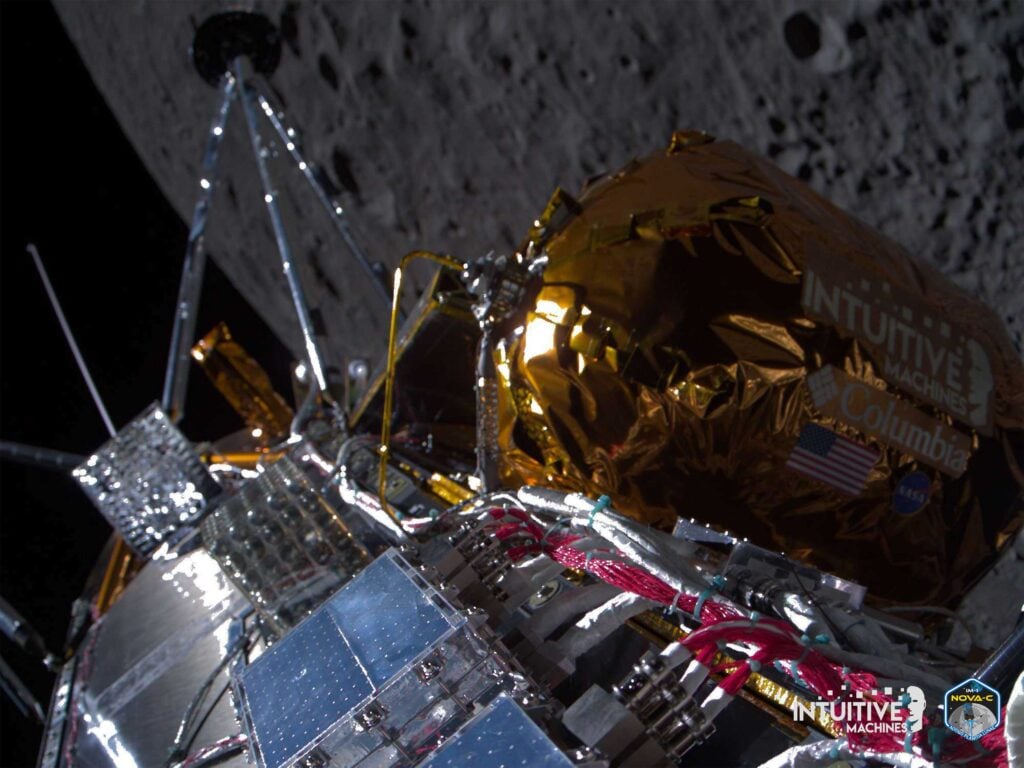The US has landed its’ first Moon since 1972, with the successful touchdown of the privately-built spacecraft Odysseus on the lunar surface.
The historic mission underscores advancements in spacecraft design while serving as a proof point for NASA’s commercial partnership model as the space industry looks to ramp up activity on and around the Moon.
Odysseus, designed and operated by Houston-based firm Intuitive Machines, made its’ precise lunar landing on Thursday, February 22nd, in the Malapert crater near the Moon’s south pole.

Landing coordinates were within 500 feet of the target, a remarkable achievement considering the spacecraft navigated itself using a backup navigation system after its primary laser guidance sensors failed pre-descent.
The landing is strategically vital given the scientific interest in the lunar south pole region. Permanently shadowed craters in this area contain caches of water ice – a vital resource supporting sustained human exploration on the Moon. Understanding accessibility to this ice is a crucial driver behind global efforts to send new robotic missions there.
Odysseus first launched into space on February 15th aboard a SpaceX Falcon 9 rocket, beginning its 4-day cruise from Earth orbit to the Moon. Weighing over 2,200 pounds with payload, the lander is Intuitive Machine’s first Nova-C model, standing roughly 14 feet tall and supported on 5-foot wide legs. Power comes from a pair of deployable solar arrays backed by onboard batteries for surviving the two-week lunar nights.
The launch and transit phase tested the resilience of the spacecraft’s hardware and computing systems. Aside from the sensor issues later in descent, the lander’s critical subsystems, including communications and guidance platforms, performed reliably throughout its journey to the Moon.
Precision Landing with Backup Navigation
As Odysseus entered the Moon’s orbit on February 21st, controllers uplinked the descent sequence and activated science instruments in preparation for landing day. Each stage of powered descent had to be carefully timed, throttling Odysseus’ main engine to gradually slow from a horizontal speed of 1,600 mph as it approached the surface.
Engineers ‘ quick thinking saved the mission when the lander’s paired LIDAR and camera sensors failed to align tracking data as expected. The navigation computer was rapidly reconfigured to utilise a backup LIDAR device contributed by NASA, guiding Odysseus safely down despite the last-minute switch.
Touchdown occurred on schedule the next day at 23:23 GMT, with jubilation in mission control once signals confirming the landing were received. In total, 4 tense minutes passed before the faint transmission from Odysseus was detected. Securing even a low bandwidth connection for sending vital telemetry and images is a challenging feat over 230,000 miles away.
Beyond restoring US presence on the lunar surface after a 50-year absence, the Odysseus mission hosts important technology demonstrations and scientific instrumentation bound to return valuable data.
Of its 18 payloads, 6 were provided by NASA to test infrastructure for future human missions. These include a navigation beacon, lunar radiation sensors, and an instrument for studying how engine plumes interact with lunar soil. Orbital images analysing the disturbance caused by Odysseus’ rocket blast will inform landing strategies for larger crewed landers.
Commercially, the mission is shepherding corporate tech experiments like an ultra-durable fabric from the clothing brand Columbia Sportswear and a cultural payload from sculptor Jeff Koons, who contributed a small art installation to the lander.
With 7 days of planned surface ops, the onboard science will measure lunar ice abundance, study the weathering of materials from radiation and micrometeorite bombardment, and demonstrate autonomous navigation techniques.
Besides spacecraft performance, backup sensor landing, and ample risk mitigation, the Odysseus mission represents two pivotal firsts – landing the first private craft on the Moon and the first American vehicle since Apollo.
Government programs drove early space achievements, but the rapid growth of the commercial space sector has enabled private companies to finance and contract complex missions independently. Intuitive Machines proposed and self-funded the entire endeavour. This represents a shift for NASA towards being an anchor customer for private services rather than owning the end-to-end development. The agency purchased payload space and transport aboard Odysseus as part of its Commercial Lunar Payload Services contract. This incentive-based public-private partnership model is pitched as promising to lower taxpayers’ burden while accelerating technological progress.
Engineering Innovations Behind Intuitive Machines’ Historic Moon Landing
The Nova-C series lander Odysseus packs some fascinating Engineering onboard. Intuitive Machines was founded in 2013 and has developed expertise in lunar access and delivery services.
The Odysseus lander features a hexagonal cylinder design with 6 landing legs spanning nearly 4 meters high. It relies on a methane and liquid oxygen propulsion system capable of producing up to 4,000 N of thrust. This allows the 1,900 kg spacecraft to perform precision landing manoeuvres as well as relocate to secondary sites after the initial touchdown.

Once landed, Odysseus can generate 200 W of electrical power using deployed solar panels. This powers the onboard battery system and supplies the suite of NASA and commercial payloads. Data and commands are relayed via an S-Band communications system. The lander also contains advanced navigation sensors and computers for autonomous hazard detection and soft landings.
The Nova-C can carry over 100 kg of instruments and cargo bound for the lunar surface across a 14-day mission lifespan. Payloads vary from technical demonstrations like advanced space cameras to cultural artefacts like sculptural artwork.
A SpaceX Falcon 9 rocket launched Odysseus into Earth orbit on February 15th, 2024. After separating from the launch vehicle, the lander fired its methane engine to accelerate out of Earth’s orbit and commence its 4-day journey to the Moon.
Critical manoeuvres, such as Trajectory Correction Burns, were completed en route to fine-tune its path. The lander then successfully entered lunar orbit on February 21st after firing its main engine to slow down. It orbited the Moon for 24 hours before initiating the descent sequence.

Intuitive Machines selected the Malapert crater site located around 190 miles from the lunar South Pole. This high-latitude region features nearly constant sunlight, which the solar-powered Odysseus requires. Teams also determined it offered smooth, hazard-free terrain ideal for the first private Moon landing attempt.

On February 22nd, after several hours of preparations, the lander fired thrusters to descend towards the surface slowly. Around 100 feet up, the EagleCam cube satellite was deployed to capture photos of the historic touchdown. At approximately 5:23 PM EST, Intuitive Machines received confirmation that Odysseus had successfully landed upright and was operational.
While the lander is not designed to survive the cold 14-day lunar night, the company received valuable data on precision landing techniques, spacecraft performance, and payload operations to inform future missions.
The success of Odysseus paves the way for an expanded role for private companies to support NASA’s return to the Moon. Intuitive Machines continues to collaborate with the agency on projects like developing moon-based infrastructure.
The flight-proven Nova-C design also serves as a platform to enable larger-scale missions. Its methane propulsion system and solar power generation lend flexibility to harvest resources via In-Situ processing on both the Moon and Mars. Intuitive Machines envisions future Nova spacecraft playing a vital part in sustainable deep space exploration and commercialisation.
If policies continue enabling private space commerce, more companies will unveil novel innovations thanks to increased technology access and falling launch costs. This establishes foundations for new services around Earth, the Moon, and beyond in the coming decade.
TLDR:
- Privately built US spacecraft Odysseus makes historic first Moon landing since 1972
- Lander touched down flawlessly despite issues using primary navigation sensors
- Landing in the south pole region enables studying water ice deposits, future fuel source
- Mission achieved two firsts: private company moon landing and the first US craft since Apollo
- Public-private partnership behind mission lowers costs and risks for complex space ops

